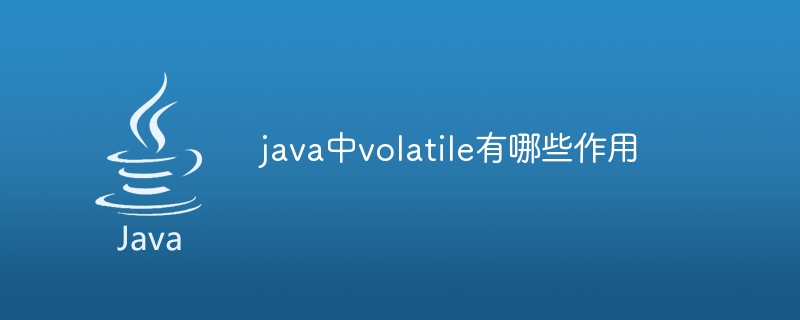Home >Java >javaTutorial >What are the functions of volatile in java
What are the functions of volatile in java
- 百草Original
- 2024-01-16 16:57:511580browse
The role of volatile in Java: 1. Prohibit instruction reordering and optimization; 2. Ensure visibility; 3. Lock upgrade and release; 4. Simplify concurrent programming. Detailed introduction: 1. Prohibit instruction rearrangement and optimization. In Java, in order to improve code execution efficiency, the compiler and processor may rearrange and optimize instructions; 2. Ensure visibility. In a multi-threaded environment, one thread can modify If the value of a variable is changed, other threads need to be able to see the modified value immediately; 3. Lock upgrade and release, when a thread tries to modify a volatile, etc.

The operating system for this tutorial: Windows 10 system, DELL G3 computer.
In Java, volatile is a keyword used to declare a variable to be volatile, that is, the value of the variable may be shared among multiple threads and may be modified by multiple threads at the same time. . The role of volatile is to ensure the consistency and visibility of access and modification of variables in a multi-threaded environment.
The following are the functions of volatile:
1. Prohibit instruction rearrangement optimization: In Java, in order to improve code execution efficiency, the compiler and processor may Instructions are rearranged and optimized. However, in a multi-threaded environment, this rearrangement may lead to data inconsistency issues. The volatile keyword can disable instruction rearrangement optimization and ensure the sequential execution of operations in a multi-threaded environment.
2. Ensure visibility: In a multi-threaded environment, if one thread modifies the value of a variable, other threads need to be able to see the modified value immediately. The volatile keyword ensures that all threads read variable values from main memory rather than from the local cache, thereby ensuring the visibility of the variable.
3. Lock upgrade and release: When a thread tries to modify a volatile variable, it will first acquire a lock. After modifying the variable, it releases the lock so that other threads can access the variable. This mechanism ensures that operations on volatile variables are atomic and avoids race conditions between threads.
4. Simplify concurrent programming: Using the volatile keyword can simplify the complexity of concurrent programming. In some cases, using volatile can replace using locks or other concurrency control mechanisms, making the code more concise and easier to understand.
It should be noted that although the volatile keyword provides some synchronization mechanisms, it cannot replace other synchronization tools, such as synchronized, ReentrantLock, etc. In some cases, using volatile may cause performance degradation or other problems. Therefore, when using volatile, you need to carefully consider its applicability and understand the principles and limitations behind it.
The following is a simple sample code showing the use of the volatile keyword:
public class Counter {
private volatile int count = 0;
public void increment() {
count++;
}
public int getCount() {
return count;
}
}In this example, we define a simple counter class Counter, which contains a volatile integer variable. Each time the increment() method is called, the counter value increases by 1. Since the count variable is declared volatile, access and modification operations by multiple threads can ensure consistency and visibility.
The above is the detailed content of What are the functions of volatile in java. For more information, please follow other related articles on the PHP Chinese website!

